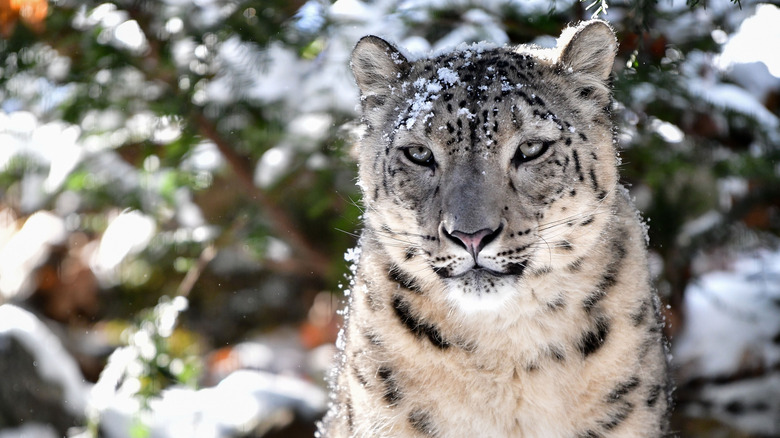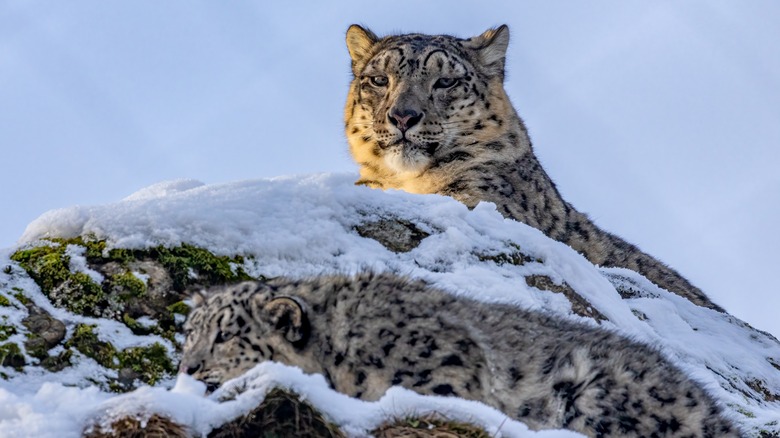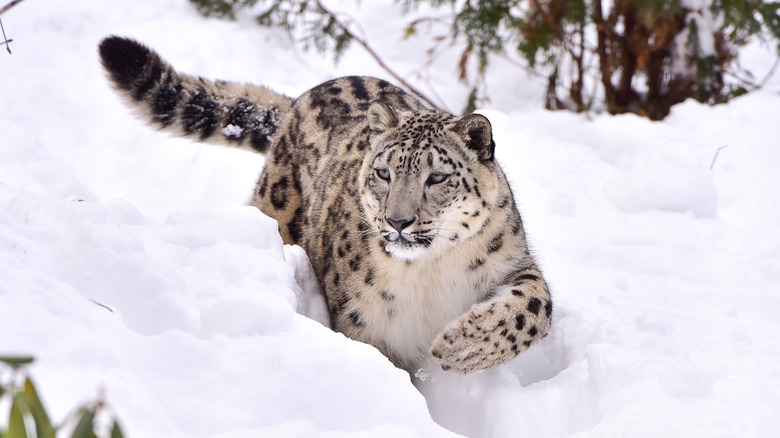This Big Cat Isn't As Dangerous To Humans As You Might Expect
The Himalayas are known for their stark desolation, a place where jagged beauty intertwines with isolated contemplation. But one of the grand ironies of trekking through these peaks is that, no matter how alone you feel, there's always the possibility that you're being watched by one of the mountain's most elusive, ethereal inhabitants — the snow leopard.
Not that you'd ever see it. James Matthiessen's 1978 book "The Snow Leopard" is perhaps the most well-known account of an expedition through the Nepalese wilderness organized with the explicit goal of witnessing the animal. But after two months of grueling hiking, Matthiessen had not caught even a single glimpse of the evasive cat. Snow leopards, perhaps more than any other animal on the planet, are simply not interested in humans, preferring to keep their distance even when they could attack. But that's not for lack of ability. At 2 to 5 feet in length and weighing anywhere between 60 and 120 pounds, snow leopards are capable of taking down prey up to 3 times their own size.
Despite being so formidable, there are zero confirmed human fatalities from snow leopard attacks, with the few confrontations that are on record resulting from the cats suffering from illnesses (like rabies) or starvation. Whenever snow leopards do come into contact with humans in the wild, they tend to retreat rather than defend their territory. Combined with the fact that their habitat is one of the most remote and challenging to navigate in the world, they hold the title of the least dangerous big cat to humans. And as it turns out, humans pose far greater a risk to the snow leopard than it does to us, which is one of the reasons why an animal (like the dodo bird) going extinct is always more depressing than you think.
Snow leopards: masters of survival
To survive one of the world's most extreme environments, the snow leopard has become a master of adaptation. These cats are found in alpine and subalpine zones across the mountain ranges of China, Nepal, Russia, Bhutan, India, Mongolia, and several other countries across Asia, inhabiting elevations of 9,800 to 14,000 feet above sea level. At these heights, oxygen is thin, temperatures drop well below freezing, and prey is scarce. Yet snow leopards thrive in these conditions. Their bodies are built for the cold, using wide, fur-covered paws that act like natural snowshoes to move silently across snowfields.
Snow leopards prefer to stick to rocky outcrops and hillsides scattered with stones and scree, and their fur coats — pale grey and slightly yellowish — are perfect for blending into this environment. This makes them incredibly difficult to spot, even if you're looking right at them. Coupled with their solitary lifestyles (they're rarely seen in groups or even pairs), they've earned the nickname "ghost of the mountain." Their thick fur provides warmth in cold temperatures, and they can wrap their tails around themselves for extra warmth. Snow leopards also have enlarged nasal cavities that help them oxygenate blood in high-altitude environments.
A single adult snow leopard's territory can be vast, occupying around 5 square miles on the low end in countries like Nepal and up to over 190 square miles in Mongolia. Throughout their range, these animals hunt ibex, blue sheep, marmots, and other mountain creatures, often ambushing prey from above with astonishing agility, leaping up to 50 feet in a single bound. But because their prey is also hunted by local communities in the area, snow leopard-human encounters have been on the rise in recent years, usually to the big cat's detriment.
Saving the snow leopard
As of 2016, snow leopards were officially listed as "Vulnerable" on the IUCN's Red List of Threatened Species. Their population in the wild only numbers from around 2,700 to roughly 3,400, though exact numbers are difficult to pin down due to their secretive nature. Snow leopards face only one natural predator, and that's humans. These conflicts tend to occur when nearby human settlements hunt for the same food that snow leopards hunt. Rather than resulting in direct, violent competition, snow leopards retreat, but to sustain themselves, they are forced to turn to killing farm livestock. This often results in retaliatory killings.
Habitat loss, climate change, and the illegal wildlife trade don't help either. In fact, the reason you're not seeing as many butterflies today as you did when you were a kid is the same reason snow leopards' future is uncertain. Warming temperatures are reshaping the fragile ecosystems of Central Asia's high mountains, pushing treelines upward and shrinking the alpine zones where snow leopards thrive. Depending on how quickly the snow leopard can adapt, it may end up extinct or on the list of animals whose evolution humans have changed. Similarly, the black market for snow leopard fur, bones, and other body parts used in traditional medicine only seems to be rising.
Thankfully, groups like the World Wildlife Fund are working to prevent retaliatory killings in Himalayan communities by helping install leopard-proof livestock pens and promoting awareness of the animal's value to local ecosystems. The fund also collaborates with government agencies to mobilize anti-poaching activities and disrupt the illegal wildlife trade. In the end, the snow leopards' power lies in endurance. These cats have survived for millennia, and with global attention and local action, they may still endure for generations to come.


